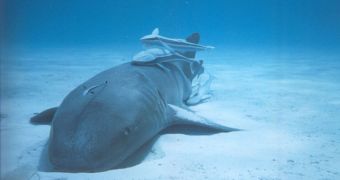Scientists announce the discovery of an impressive new fossil in the United States. Experts digging at a site in Kansas have unearthed a number of fragments belonging to a huge aquatic predator, including scales, teeth, and a very large jawbone. This gave them an idea as to the size of the marine creature, most likely a type of sharks, which is estimated to have lived about 89 million years ago. Apparently, the animal was proficient at consuming giant clams, and other large, shelled creatures, as evidenced by the huge tooth plates it was endowed with, the BBC News reports.
Reconstructions of the shark, based on the jawbone, show a creature about 10 meters (33 feet) in length, which lived most likely at the bottom of the sea. This is not the first fossilized remain of this particular beast, but thus far paleontologists believed that the creature was a lot smaller. Therefore, the new measurements came as a shock to them. Scientists behind the investigation published the results of their work in last week's issue of the respected scientific publication Cretaceous Research. They also included details about newly-found plankton-eating fish, which apparently lived some 100 million years ago in the world's oceans.
The fossilized predator, called Ptychodus mortoni, is believed to have lost its appetite for plankton over the course of its evolution, and to have developed a taste for flesh. According to some analysts, the beast may have even been the largest shellfish-eating predator in the world. At this point, animals that do that are nowhere near the size of P. mortoni. Its remains were discovered in deposits called Fort Hays Limestone, in Kansas. The work was conducted by DePaul University scientist Dr Kenshu Shimada.
“Kansas back then was smack in the middle of an inland sea known as the Western Interior Seaway that extended in a north-south direction across North America. Although it represents a fraction of the entire body of the shark, the jaw fragment is gigantic. The estimated jaw length was almost 1 [meter] long, and that would suggest that the shark was likely at least 10 [meters] in length,” the expert explained. Although there is no possible way to be sure, scientists estimate that the ancient predator may have looked somewhat like the modern nurse shark, called Ginglymostoma cirratum, which features a broad rounded head, atop a stout body.

 14 DAY TRIAL //
14 DAY TRIAL //